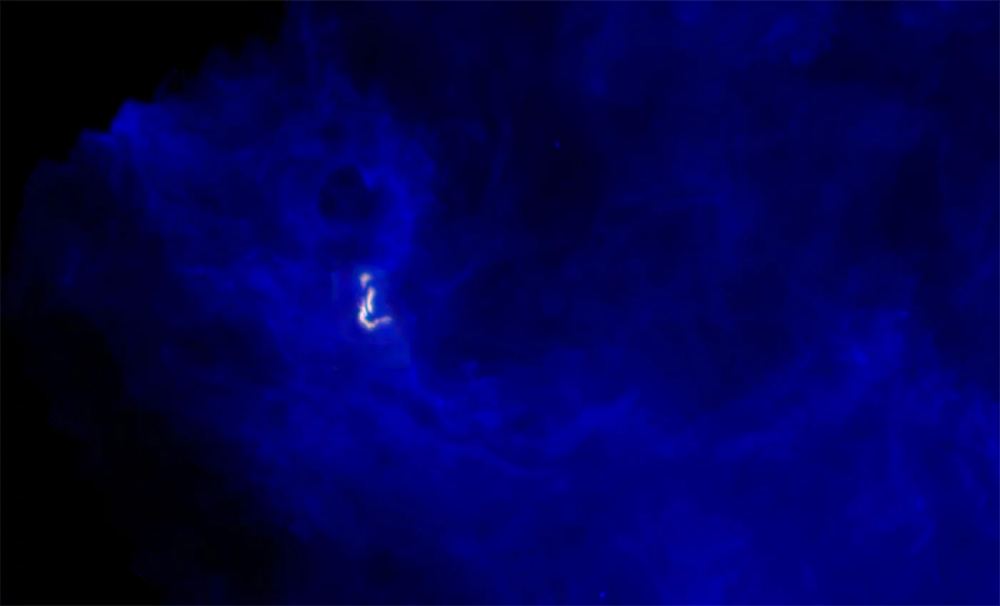When stars are born, they do it inside a molecular cloud. Astronomers long assumed that the “crèche” supplied all the nutrients that protostars needed to form. However, it turns out they get help from outside the nest.
A new study by scientists at the Max Planck Institute for Extraterrestrial Physics delved into the role of streamers and filaments in the star-birth process. Think of them as channels that extend out from the interior of the stellar creche, sometimes out as far as 10,000 astronomical units (about 0.15 light-years). The research team found a connection between these streamers and filaments and star-formation activity. Essentially, the streamers provide a star-forming disk with fresh gas to nourish the baby star as it grows.
Star Formation at a Glance
The standard story about star birth goes like this: cool, dense molecular clouds are the crèches of stars. The material begins to accumulate preferentially in one part of the cloud. These clouds are mostly hydrogen but also contain other elements. For example, supernova explosions seed nearby molecular clouds with heavier elements (such as iron).
As the cloud contracts, its own self-gravity pulls in more and more material. Eventually, the temperatures and pressures get high enough in the “overdense” region that a protostar begins to shine. It continues to grow, attracting more and more material. At some point, nuclear fusion begins in the core of the region, and that’s when the star is born.
This whole process takes millions of years and also involves magnetic fields and other factors. However, when astronomers noticed strange streamers and filaments in star birth regions, they wondered what roles they played in the process. They also speculated about the origins of these structures.
Looking at Protostars in Barnard 5
A team at Max Planck, led by Ph.D. student Maria Teresa Valdiva Mena, focused on a particularly interesting star in the Barnard 5 region of the sky. This is a molecular cloud that lies in the direction of the constellation Perseus. There are actually several protostars in the area, but one sports two filaments. To get a handle on what’s happening there, the team used the Atacama Large Millimeter Array (ALMA) in Chile, along with two other telescopes to study the filaments. “Our aim was to trace the journey of gas from outside of the filament that contains the protostar to the protostellar disks, bridging the gap between different scales of star formation,” said Valdivia-Mena, lead author of the study.

The three different telescopes showed that the streamers are conducting chemically fresh gas from the larger nebula into the birth envelope. The ALMA data actually showed a streamer feeding right into the protostellar disk surrounding a soon-to-be-born star. The streamers and filaments seem to be an integral part of the starforming process by providing material from other parts of the nebula.
“These results are very exciting because they show that the star-formation process is a multiscale process,” said Jaime Pineda, second author of the Barnard 5 study. “Accretion flows and streamers connect the young stellar objects with the parental cloud. This dynamic process of feeding the young star might even affect the whole disk and planet formation process, although we need future observations to confirm this.”
Protostars and Planets
It isn’t just stars that are influenced by these flows of fresh gas into a birth cloud. Their future planets will show the chemical influence exerted by filaments and streamers. Just as a quick review, a star’s planets form from material in the protostellar disk. Generally, this protoplanetary disk contains material that has been processed by heating, which affects the formation of both rocky and gas- and ice-giant worlds. Generally speaking, the interior of the disk is likely to have a great deal more rocky material than the outer regions. That’s because higher temperatures destroy volatiles such as hydrogen, leaving behind heavier materials. The outer regions are more “habitable” for volatiles and ices. That’s the general case, and of course, each system has its own quirks.

In a system like Barnard 5, the filaments and streamers inject fresh material from other parts of the nebula. That material has a different chemical composition and “fingerprint”, which will show up on future planets. The incoming material is actually “pristine”. That means it hasn’t been influenced by the temperatures, pressures, and magnetic environments of star birth crèches.
The compositions of any newborn planets at Barnard 5 will have the chemical fingerprints of the incoming materials. So, this in-depth look at star formation is a blueprint for understanding streamers and filaments in other such regions. Astronomers already knew that star birth nurseries were complex places. This new data gives even more insight into how that complexity comes about. “Our research emphasizes how interconnected various scales in the star formation process are, highlighting the profound impact of these flows on the evolution of nascent stars,” said Valdivia-Mena.
For More Information
Protostars Feed from Beyond Their Envelopes
Flow of Gas Detected from Beyond the Filaments to Protostellar Scales in Barnard 5

